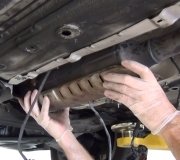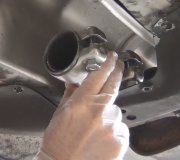I can only share what I learned from the person I worked with. The comment about nitrogen oxide is not correct. That gas was blamed for acid rain years ago. It is caused by burning fuel at very high temperatures. That is why diesel engines are the biggest contributor. That gas will cause burning eyes and nose. With gas engines, nitrogen oxide is reduced or eliminated by using exhaust gas recirculation, (EGR valve). That puts inert exhaust gas into the cylinders. By partially-filling them with that, there is less room for fresh air and fuel, so less heat is generated.
Starting with '96 models, all cars and light trucks have the "on-board-diagnostics, version 2", (OBD2) emissions system. The exhaust from them is so clean, you can suck on the tail pipe and live to tell about it. If the catalytic converters are working properly, the exhaust is carbon dioxide and water vapor. Typically you'll see water dripping from the tail pipe or the drain hole at the back of the muffler.
There have been anecdotal stories for years about people becoming sick from the special gasoline formulations required in some parts of the country. The politicians create one problem when trying to solve another problem.
I have a hard time believing the exhaust is the cause of the problem because you're breathing the exhaust from the car in front of you, especially when in slow-moving or stop-and-go traffic. The common factor in all of these complaints is the manufacturer. If the cause of the sickness is the gas, the complaints should come from people with all different car brands.
If you suspect fumes are entering the passenger compartment from the engine area, I would entertain a notion to do a miniature version of wind tunnel testing. Part of the OBD2 emissions system includes a means to collect fuel vapors so they don't get released into the atmosphere, and a means to monitor that system. The Engine Computer can detect very small leaks that we would never find with a visual inspection. To address that, the industry came up with "smoke machines". They generate a white, non-toxic smoke that can be injected, then we watch for where it sneaks out. I would be tempted to try to use that to see where the smoke can be made to blow into the passenger compartment. There's only two places I can think of. One is all cars with factory-installed air conditioning have a drip pan for the humidity that condenses out of the cooled air, and a drain tube in front of the firewall to get rid of that water. There's usually a 4"-long rubber hose with a 90 degree bend hanging down, and little air can flow in there.
The second place is the air inlet for the heater system. The only fumes that might come off the engine are from vaporizing oil that has leaked out previously. To prevent those fumes from going into the inlet vent, there's a long rubber weather seal attached to the rear edge of the bottom of the hood. I'd look for that to be missing on a car that was repaired after a crash.
None of my potential suspects should apply to new cars that have never been damaged. My observations are based on logic, and we all know that doesn't always pan out. Hopefully someone will post a better solution.
Tuesday, May 30th, 2017 AT 1:20 PM


